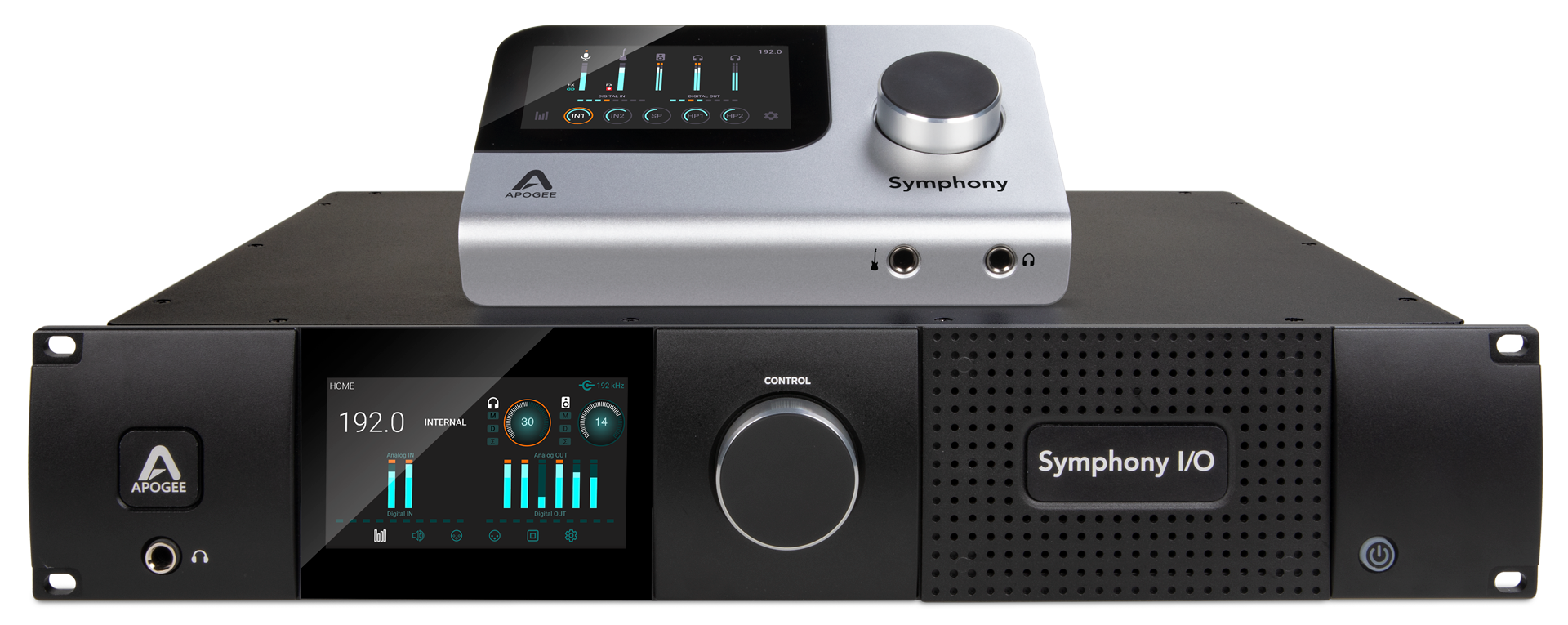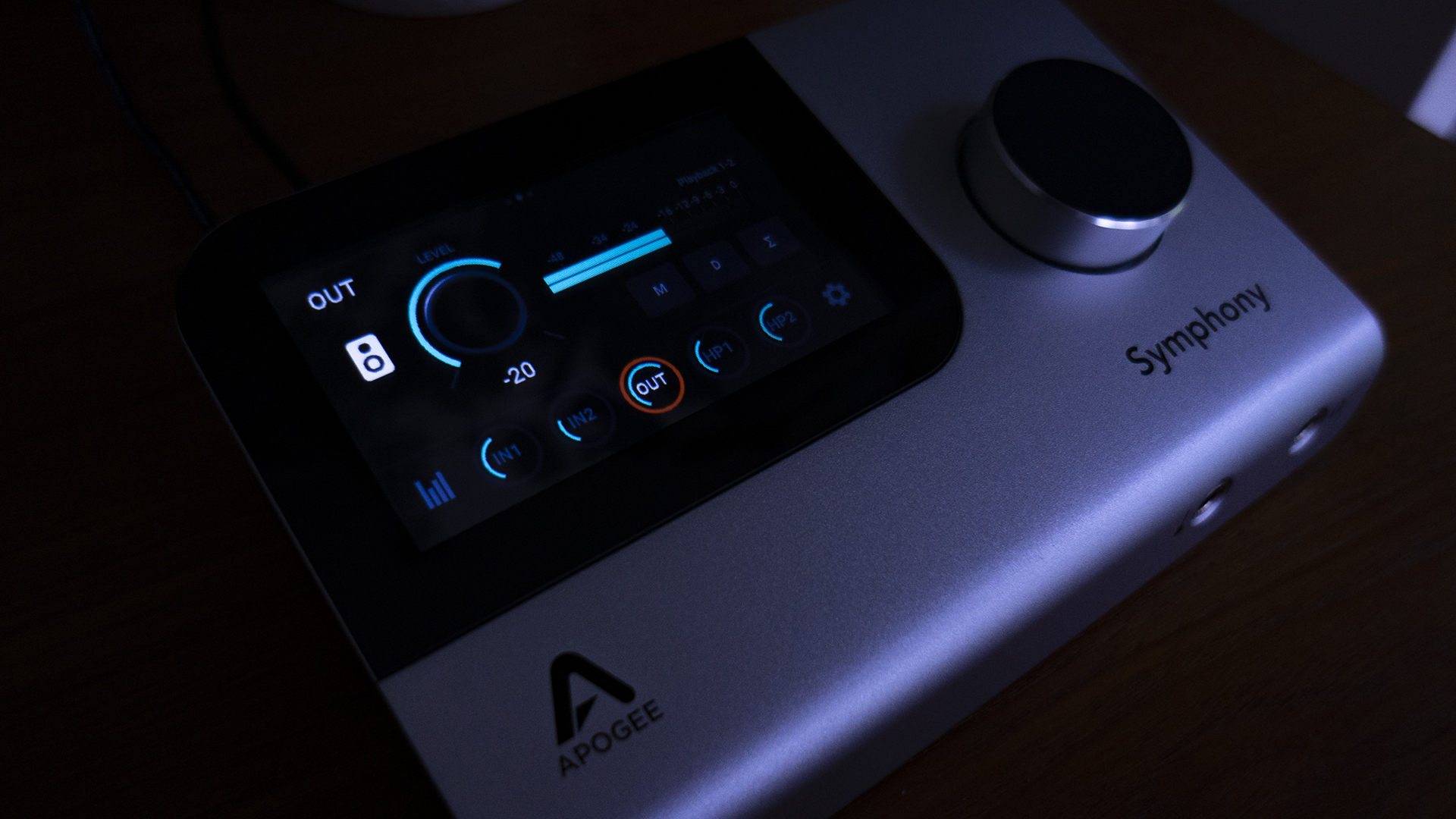
For nearly a decade, Symphony I/O has been the flagship audio interface for Apogee Electronics. Both the 1st and 2nd generation models have boasted premium quality conversion with configurable I/O for unparalleled flexibility. The latest addition to the range - Symphony Desktop – continues this legacy in a smaller format. Despite its size, it still maintains the same high-quality performance that you would expect from an interface bearing the Symphony name.
Symphony Desktop is a more portable and cost-effective alternative to the Symphony I/O. It’s designed for artists & engineers looking to record / monitor audio at a professional level, whether they’re on the road or working from home. It also has a few additional tricks up its sleeve when it comes to plugins & DSP.
In this first look at Symphony Desktop, we’ll explore what this brand-new interface has to offer.
Symphony Desktop is designed with your desktop in mind. Its small footprint makes it the ideal interface and monitor controller for those who need professional sound outside of the studio. It could very easily take place as the heart of a project studio or home setup, with options for expansion if you need more I/O.

Due to its size, Symphony Desktop is also very portable. The chassis is constructed from die cast aluminium, and the glass screen is specially treated, making it a resilient travel companion. Not to say the Symphony I/O isn’t portable, but it’s probably easier to pop a small interface in a rucksack then it is to lug around the 2U 19” rackmount version!
This is arguably one of the most important questions about an interface. We can tell you now that Symphony Desktop has a total of 10 audio inputs & 14 audio outputs.

Firstly, we have the two analogue inputs on the back panel. They are combi-jack inputs (¼" TRS or XLR) that accept mic or line audio sources. These feed the advanced stepped gain mic preamps, which provide up to 75db of transparent gain with ultra-low distortion and noise. The preamps on Symphony Desktop have a brand-new design feature – Alloy Mic Preamp emulation - which we’ll talk about more later...
For guitarists & bassists - there is a FET instrument input on the front of the interface as a direct input for your guitar. This is especially designed to resemble the sound of a tube amp, giving your DI a rich sound full of tone. The instrument input is linked to the second input channel of the interface.

If you're in need of additional inputs, Symphony Desktop has an optical input for ADAT or S/PDIF. For those of you who are unfamiliar with optical, it’s a digital port that can be transformed into 8 analogue inputs by using a digital expander - giving you a total of 10 audio channels with the onboard inputs.
So, if you were wondering if you could record a multi-mic'd drumkit with Symphony Desktop – the answer is yes, with an ADAT expander!
Onto outputs – There are two balanced ¼" Jack outputs for monitors, up to 8 digital outputs via the optical out port. You also get two assignable headphone outputs, which can be assigned their own mixes using the Symphony Control Software. This is ideal when recording other musicians who may need a separate mix from the main output.
Symphony Desktop uses USB-C to connect to your Windows, Mac or iOS device (with lightning adapter). You’ll also notice there’s a USB-Host connection. This can be used for USB peripherals such as MIDI controllers – particularly handy when USB sockets are at a premium!
Symphony Desktop houses the same converter technology under the hood that you’d find inside the Symphony I/O. Apogee converters are known for their accuracy and clarity, allowing you to capture all the subtle details of a performance in digital format without imparting any audible distortion or noise artifacts associated with lower quality converters.

‘Symphony uniquely employs a fully differential op-amp as a fundamental building block throughout its analog circuits. The very latest iterations of this technology offer astounding performance – vanishingly low noise and distortion, lightning-fast slew rate and out-sized current output capability, all in a power efficient and small package. These components offer performance that’s orders of magnitude superior to what’s found in most competitive audio interfaces.’
The digital-to-analogue or output stage of conversion is just as important as the input. With superior D/A conversion, you can be more confident that you are making the right choices when editing & mixing your projects. As you would expect, Symphony Desktop uses high quality components on the D/A stage too, giving you a precise output of your mix.
The dynamic touch screen interface on Symphony Desktop gives you instant access to all the settings. It’s the very same one that you’d find on a Symphony I/O MkII. From here, you have control over the gain, phantom power, phase, soft limiting and grouping of both preamps – without needing to touch your computer. You can even save your configurations as presets on Symphony Desktop for quick recall.

Through the touch screen you can also control the level, mutes, mono summing and dimming for the output channels. For more advanced routing, headphone mixes and other settings, Symphony Desktop can be used with Symphony control software.
The onboard controls also access Apogee’s Alloy preamp modelling & Dual-Path plugins which we’ll look at in greater detail in this next section...
One of the big features that sets Symphony Desktop apart from other interfaces is its clever integration of DSP to run plugins and emulate mic preamps.
Symphony Desktop is equipped with Apogee Alloy Mic Preamp emulation. A combination of DSP processing and some clever analogue circuitry transforms your inputs to sound like some of the most sought-after studio hardware. Critical aspects of the model such as input impedance, transient profile and distortion characteristics are first implemented in the analogue domain, followed by precise and accurate refinement in DSP, for a hybrid result that’s greater than the sum of its parts. There are currently 2 emulations available – ‘NV-1066’ modelled after the Neve 1066 & ‘AX-601’ designed to sound like a 50s era Ampex 601. With more emulations in the works, the Alloy Mic Preamps will have even more to offer in the future.

Symphony Desktop is also compatible with Apogee’s Dual-Path plugins. It uses the onboard DSP processing to host the plugins. This means you can monitor or print (record) using Apogee’s plugins with near zero latency. Dual-Path plugins can also be used natively ie. without the interface plugged in. Even if you don’t have access to your Symphony Desktop, you can still use the plugins in your DAW.
As standard, Symphony Desktop is bundled as standard with Symphony ECS Channel Strip and Clearmountain’s Spaces Reverb - two awesome plugins designed in conjunction with Bob Clearmountain. For a little extra upfront, you can also upgrade your bundle to receive the whole suite of Dual-Path plugins and make the most of the onboard processing power.

‘Tuned by Bob Clearmountain, the Symphony ECS Channel Strip plugin includes EQ, compression and saturation processing that’s powerful, but easy to use so you can sculpt the tone dynamics and clarity of your recordings all from one plugin.’

‘Clearmountain’s Spaces is a simple but distinctive reverb plugin, with 3 of legendary mixer bob clearmountain’s favourite room and echo chamber spaces, plus his expert input processing. Clearmountain’s Spaces lets you envelope your tracks in unique and cohesive atmospheres that set your mixes apart.’
Needless to say, we’re very excited to receive the first shipment of Apogee Symphony Desktops. Taking the studio-grade components of the Symphony I/O MkII and putting it into a compact form factor makes Symphony Desktop a truly exciting addition to the range. It’s the perfect tool for achieving professional results with your audio, whether you’re at home, on tour, or in the studio.

This new blog is presented by the team at Sound Technology Ltd, a leading distributor of musical instruments and pro audio equipment in the UK and ROI.